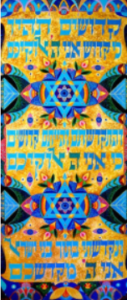Parshat Shmini 2022
By Rabbi Moshe Goodman, Kollel Ohr Shlomo, Hebron
בס”ד
לשכנו תדרשו
Discover the Holy Presence in Our Holy Land
And You Shall Be Holy

In this painting we see the words of the verses in this parsha, discussing the sanctity of the Godly People Israel, in the color of sky/”heavenly”-like azure, the color associated by the Kabbalists to the Supreme [sefira of] Wisdom. Indeed, the Kabbalists tie the concept of “kedusha/sanctity” to this very sefira of Supreme Wisdom. This Supreme Wisdom is considered a very lofty Godly aspect, and indeed the verses mentioned here describe how the People of Israel are supposed to become holy by emulating God “Who is Holy.”
Due to the sacred state of Israel, it seems that painted here at the center is a Star of David hinting to this People, for these are two sides/lines to each of the six corners, altogether becoming twelve lines, hinting to the twelve Tribes of Israel. Also the number six in the six corners hints to Israel as the dominant number in Israel’s census in the Widerness is also six [hundred thousand – this matter is discussed in many holy works; not my novel understanding].
There are two Menoras from above and below at each side of the Stars of David, altogether four Menoras. It seems that here a connection is made between the seventh “space” in the center of the Star of David, which has been associated by scholars to hint to the sanctity of the “seventh aspect” associated with holiness in the natural world. Therefore, next to these stars of David are Menoras that have seven lamps to them. These are paired expressing the sanctity that comes through the “pairing/couples” we have mentioned in the past in Nachshon’s paintings (see parshat Vayakehel).
Thus, in this painting we see two themes based on the numbers six and seven. Perhaps their relationship is as follows: We are familiar we these two numbers in the context of the six “mundane” days of the week versus the Seventh Holy Day of Shabbat. As the verses in the painting suggest, we can turn our “mundane” lives into lives of holiness. Hebron too carries this theme for in Hebron are buried our holy Patriarchs and Matriarchs, who sanctified their “mundane” lives to such an extent that their lives are recorded in the holy Torah in fine detail as role-models for all generations.